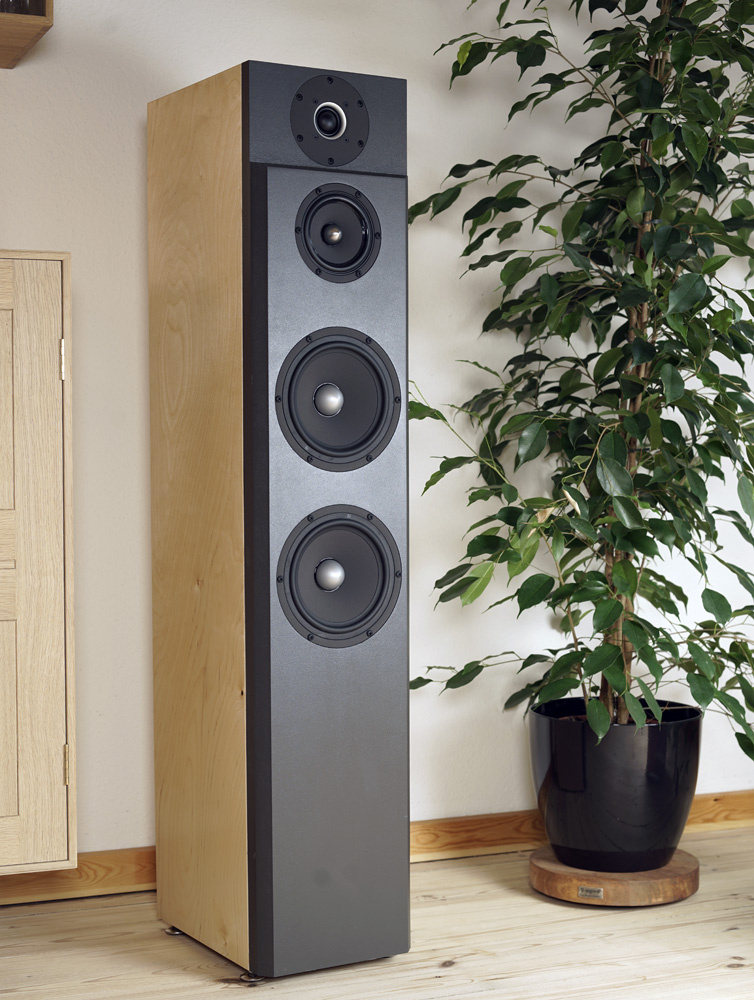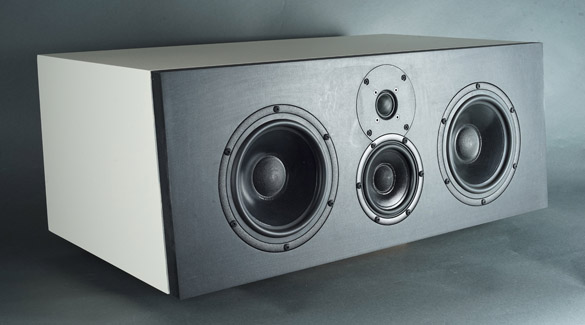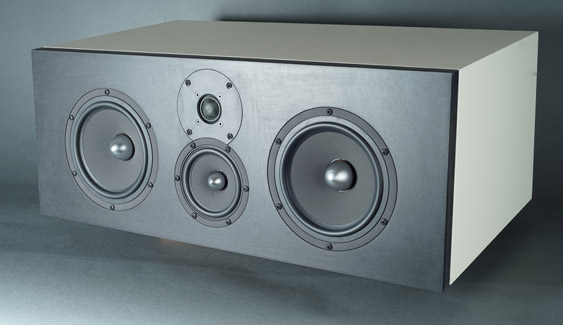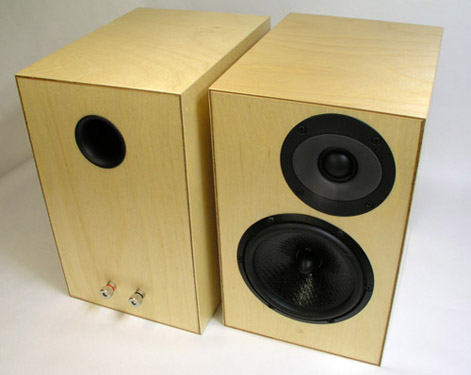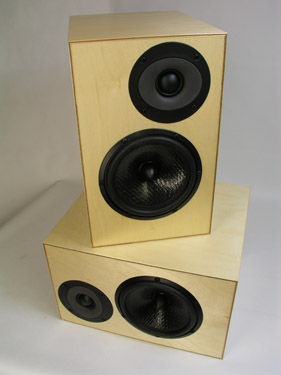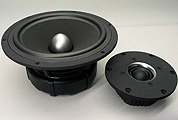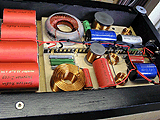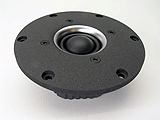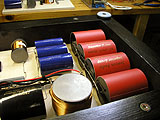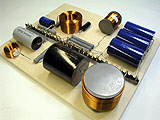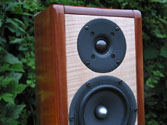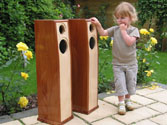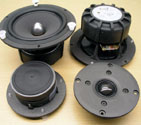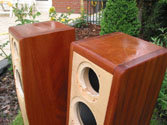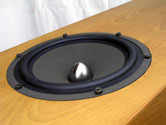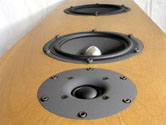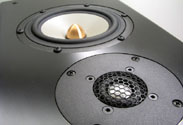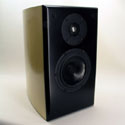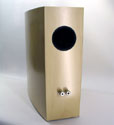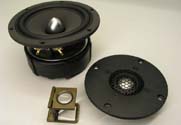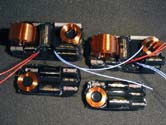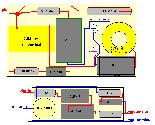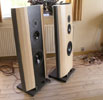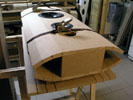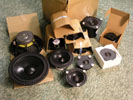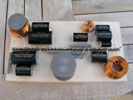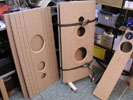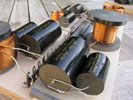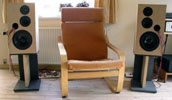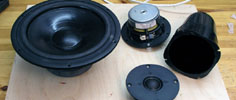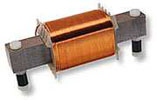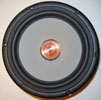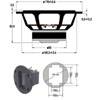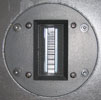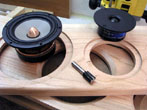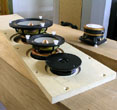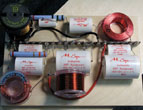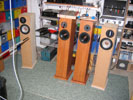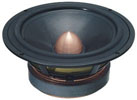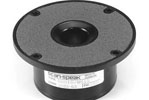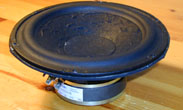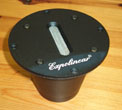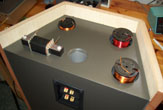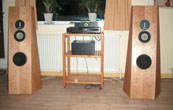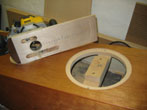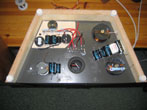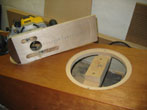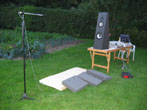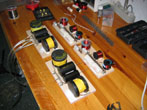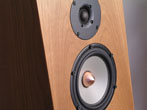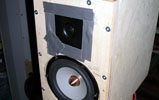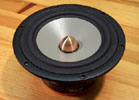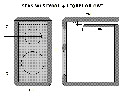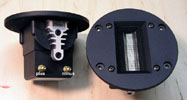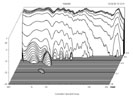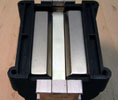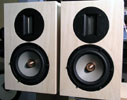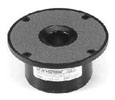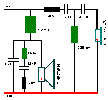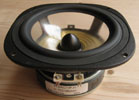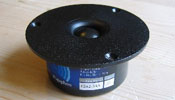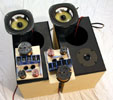|
DIY Loudspeakers: HOME INDEX UPDATES RESPONSE WHAT'S NEW
SEAS projects CNO-4 Since I received the new W18NX003 drivers
they'd been sitting in my
CNO-25
speakers, so they were well broken in when I moved two of them to
the CNO-4 cabs. I loved what they did in CNO-25, but it wasn't until
the CNO-4 set-up that I could fully appreciate the qualities of this
new driver. Installing the speakers in our living room I initially
didn't think them as efficient as I had expected - only to find out
I was playing them louder than normal! A very good sign of low
distortion. The W18NX... has all the qualities I could ask for from
a 6" driver. Utterly transparent and dynamic combined with an
overall smooth response that doesn't make it selective on
recordings, nor favour any musical genre.
It's been quite a while since I last worked with the Nextel coated
drivers from the SEAS EXCEL line - and I'd forgotten how good they
are. I fact, I never heard how good they can be as my front
gear is much better today that it was back then. CNO-25-mkII is a logical extension of the virtues of CNO-mkIII. The extra midbass provides additional power handling and bass impact. Revised simple crossover and time-aligned drivers. Fitted with some of the best drivers from the SEAS EXCEL line of drivers and state of the art crossover components from Jantzen Audio.
CNO-GRANDE is the third speaker in a range of upgraded and new CNO
constructions and icing of the cake from 2 x W18NX001 + W12CY003 +
T29CF002. Amber-Z cap for the tweeter ensures absolut optimum
performance from this SOTA tweeter. Edge-coated midrange driver
ensures smooth and non-distorted midrange performance. 1st order
crossover to midrange and tweeter.
SEAS CENTER-641 SPEAKERS Center speakers should be 3-ways! Many center speakers are made from the popular 2-way d'Appolito - and I've made a few myself - but from a center speaker we need a strong midrange projection and we need an even horizontal dispersion, something 3-ways are good at. We need everybody in a 4 seat sofa to get the same experience. The strong midrange projection makes understanding speech and vocals more easy and in this respect these center speakers are no different from the Classic 3-ways (SEAS and ScanSpeak) recently introduced. The same goes for Ekta, Ekta Grande, SP44, SP38, all featuring 2-4 inch midrange drivers.
SEAS
3-Way-Classic mkII
Given the size*, this is a speaker that might please a lot of people and annoy a few - if any! Smooth is what is - and efficient too. With a healthy 90-91 dB sensitivity it's 1-1½ dB more sensitive compared to the mkI - and an easy load for even fairly low wattage tube amps. I recommend minimum 15-20 watts to get some of the dynamics. More power always means better grip on cones and better low-end punch. My 50 wpc GlowMaster KT88 loves it. If you never play very loud, 5-10 watts will obviously do too - in particular PP designs having better bass grip. Smooth when music is smooth, harsh when music is harsh. Read about the latest and best SEAS speaker I've ever made.
SEAS
CURV mini two-way Try out the un-coloured sound of woven PP.
Jenzen NEXT
The Jenzen NEXT
comes at roughly twice the price of the
Jenzen
SEAS ER kit, so what do we get for the money besides gorgeous
looks of nextel coated drivers and silver phase plugs?
Jenzen
SEAS ER The Jenzen series of
speakers are meant to offer high-end sound for low-end price, even for
the constructions to come with expensive drivers. As discussed in
Speakers' Corner; what we diy people can do at modest price the speaker
manufacturers cannot, is this: Spoil our drivers with the best of
cabinetry. The first speaker in the Jenzen series comes with modest priced drivers, yet delivers a significant soundstage. Size matters and using drivers with a decent membrane area means they don't have to move much. In particular for the midrange this is important and releasing it of the tedious task of pumping bass, things start developing. Drivers we may have found delivering harsh upper mids in the common two-way set-up may all of a sudden deliver crystal clear sound in all of the midrange.
SEAS CA18RNX
2½-WAY
These SEAS CA18RNX drivers hold the
classical coated paper cones, but here with a 39 mm voice
coil former allowing greater power handling compared to
CA18RLY's standard 1" voice coil. Overall frequency
response is better for the CA18RLY, but despite a
somewhat whobbly midrange they sound smooth, detailed and
throw a punchy bass. Read more by clicking heading or
image.
CNO-25, 2½-way
CNO Discontinued Setting up the finished CNO-25 revealed a fully grown-up CNO. Sensitivity is increased by 4-5 decibels and the overall bottom end weight is significantly enhanced. Comparatively it goes louder with less distortion due to doubling the amount of bass drivers. Upper mid and treble is the same as for the CNO and this was what I wanted: Maintain CNO qualities, but increase power handling and bottom end capability.
CNO mkII Discontinued
These drivers were not only made to look good, but also to provide a sound clearly distinguishable from the average. High-end drivers built on classic virtues. As always we apply to the law of diminishing returns when we buy expensive stuff. Small improvements may cost small fortunes. I think these nextel units are the best sounding drivers SEAS has ever built. A slightly modified crossover delivers an overall balanced sound that will suit any kind of source material. My absolute favourite 24 liter floorstander.
CNO-T25 Discontinued The CNO mkII modified for SEAS T25C003 tweeter.
Scoperta
Mini transmission line from
If size matters, here is a neat mini-TL
that will deliver potent bass,
Acapella NEXT
Semi-dipole from state of the art drivers
My Autumn sale was a
goodbye to my Acapella SEas speakers. Drivers,
crossovers, vents, terminals, damping material, wires,
everything but the cabs. You don't ship these caps to
Portugal unless you make huge crates with loads of
absorbent material. So, the cabs stayed and having the
W18 and T29 drivers the only thing left to do was
ordering the W22 bass units - and see if a fairly high
efficient Acapella could be made. The W22 comes with a
huge 134 mm magnet and promises 90 dB sensitivity. Not
bad at all. Maybe the W18 could even be run without any
attenuation.... So, the Acapella NEXT was born.
SEAS
5INCH projects
SEAS
EXCEL W12CY003 + 22TAF/G
Poor
Man's Strad
The "Poor Man's Stradivari"
made from SEAS CA22RNX + MCA15RCY + slightly modified
27TFFC have been finished. Various tweeters (Vifa DX25TG
and Scan-Speak D2905/9700) have been tried and the
crossovers have been added to the website.
Having made an EXCEL version of this speaker (read below) I returned to the "paper" drivers and this is how it's going to be. They may not be as neutral as the EXCEL drivers but they just have "something". Sensitivity and transient attack to point out two things. Feeding these speakers from my old Garrard 401/modified Rega RB300/Dynavector 10x5/Copland CTA 505 power amp provides lots of good moments and secondhand vinyl is available in truckloads for nothing these days. Click heading to go to PMS. I have to say the PMS is a hit in terms of feedback from builders. A lot of people have had fun making 3D drawings of the cabs and I have feedback from 20+ people building the PMS. A few have reported back with pics and comments and I hope to have some more photos of finished projects this year.
SEAS
Classic 3-way
The SEAS CA22 was tried in a classical 3-way and it turned out so well that I have launched the project. The MCA12 is doing excellent and provides a fine midrange with a wide dispersion and a speedy presentation that leaves most 6-7" midbass drivers behind. These paper-coned drivers take some burn-in before delivering the goods. The tweeter is the 27TFFC, an fine tweeter at a modest price. Sensitivity is 90 dB/2.8 volts and it's an easy load on the amplifier. The crossover is a simple 2nd order topology and the overall cost for drivers and crossover components is around 535 €. I have to admit I have had very little feedback on this speaker. I know that MDF cabs have very little appeal* and the classic cab is out of fashion. Maybe some gorgeous veneer would make a change. I'd pick this speaker any time over the 2.5 clone/Amish 45-95 and others.
*When I first launched the TJL in MDF test
cabs there was absolutely no response at all. I then made
a digitally manipulated image of the drivers in a very
nice looking yew veneered cabinet - and then things
started rolling. So, do we choose speakers by ear or eye?
TJL,
2-way floorstander Discontinued
The following project describes a 2-way
floorstander slightly smaller than the 2.5 clone. Overall
dimensions are: 19 x 98 x 26 cm (W x H x D). This project
is targeting a better midrange, better treble, bass
comparable to the 2.5 clone and a more moderate-sized
cabinet. Well, can all these requirements be accomplished
in a smaller-size construction? And from what drivers?
TJL-3W,
3-way floorstander Discontinued
I do think I've been writing quite a lot
about the TJL 3-way. The experiences gained from the Ekta
and Zahra made me even more anxious to get started. If
the latter two constructions hadn't come along, I would
have done the TJL3W a long time ago. But events took
their own course and I have been pleased with the results
of the former constructions and the TJL3W was very much
next. The TJL is my favourite among a number of 2-way
floorstanders and you always ask how to make a good thing
better. The TJL shares the limitations of most other
6" + tweeter two-ways: Lack of dispersion in the
upper midrange/lower treble due to the bass driver having
to handle everything up into the treble area despite the
low point of crossover around 2500 Hz. When a single
driver has to pump the deep bass and at the same time
handle the delicate upper midrange and lower treble there
are limitations to the loudness we can expect from such a
design. Suitable for most, but it can't play excessively
loud. However, the TJL3W wasn't made to play excessively
loud, rather to play low. Read full text and construction details on TJL3W
W17EX001
+ Scan-Speak D2010/8513 Discontinued
This speaker, building on a well-known
commercial floorstander, is an easy project in a modest
24 litre cabinet.
Point75
(pdf file) Discontinued
Despite having a ScanSpeak bass driver,
this construction is placed in the SEAS section due to
the SEAS W15CY001 middriver and a later upgrade with an
8" SEAS alu driver. Discontinued
Point75A upgrade by using SEAS L22RN4X/P (H1208) for bass. Modified crossover. New construction can utilise Fountek JP3 or Aurum Cantus G2Si ribbons as well. Read up-grade of Point75A to Point75i Acapella LT & LWJ (6 MB pdf file) Discontinued
The aim of this project is to use the
experience gained from the Point75 to produce a speaker
with greater power handling and SPL capability. In other
words, it has to be able to play loud - and retain all
the qualities from the Point75. In addition to this, some
more weight/warmth in the lower/middle midrange would be
appreciated.
Acapella
SE (3 MB pdf) and
SEas
(htm)
This is the speaker that is the steady
back-bone in my hifi set-up. Not a particularly
complicated speaker, a standard 3-way with an 8"
bass driver working up to 350 Hz. A 6" midrange
working from 350 to 2500 Hz and a ribbon tweeter taking
over from here. Recently a SEAS T25 dome tweeter is
taking the place in replacement of the ribbon. Some day
I'll make a four-way of this construction just to hear if
it is possible to fully integrate four drivers. Not an
easy task. The ribbon version is a tolerable set-up where
the T25 version has an extra 1-1½ dB in the 1-3 kHz
region providing a more forward presentation.
7.5 litre vented construction - a fabulous mini-monitor. This construction was made before I started my diy-loudspeaker website, and I never found the time to write anything about it. The drivers here are among my favourites and the W15CY001 drivers were acquired for the Point75 dipole speaker and the HIQUPHON OWI was bought only because I wanted to own a pair of these - probably - best ever made 19 mm domes. Some people find the OWI tweeter hard to find, but it's not. The OWI and other magnificient tweeters are made by Oskar Wroending here in Denmark and his website is here. You cab buy all types directly from Mr. Wroending or find a distributors list here.
W15CY001
+ Fountek Neo3
I recently had a pair the Fountek NeoCD3 ribbon tweeters and have compared them to the JP3 true alu-ribbon tweeters. The new tweeters have a ribbon made from laminated material and will probably be less fragile compared to the JP3 pure alu ribbons. The easiest way to try out the Neos was to set up a small monitor and the SEAS W15CY001 midbass was an obvious choice. You don't find a much better upper midrange and from a 7.5 litres cabinet you get a surprisingly deep bass. I also tried adding a subwoofer from two push-push Dynaudio 21W54s with a crossover around 60-70 Hz/12 dB and it worked fine. Discontinued
One of my friends needed a mini for his home studio and I suggested the SEAS T14RCY having the XP membrane material giving an ear-friendly midrange with excellent transparency. The ScanSpeak D2010/8513 tweeter in this company is sweet and gently, nowhere near how it performed with the 18W/8535 driver in the 2.5 Clone. The 8513 tweeter must never be mated with an even slightly harsh midrange. An even better tweeter option may be the HIQUPHON OW1. The T14 is getting hard to find and a replacement system is planned from SEAS CA15RLY + 22TAF/G. |


